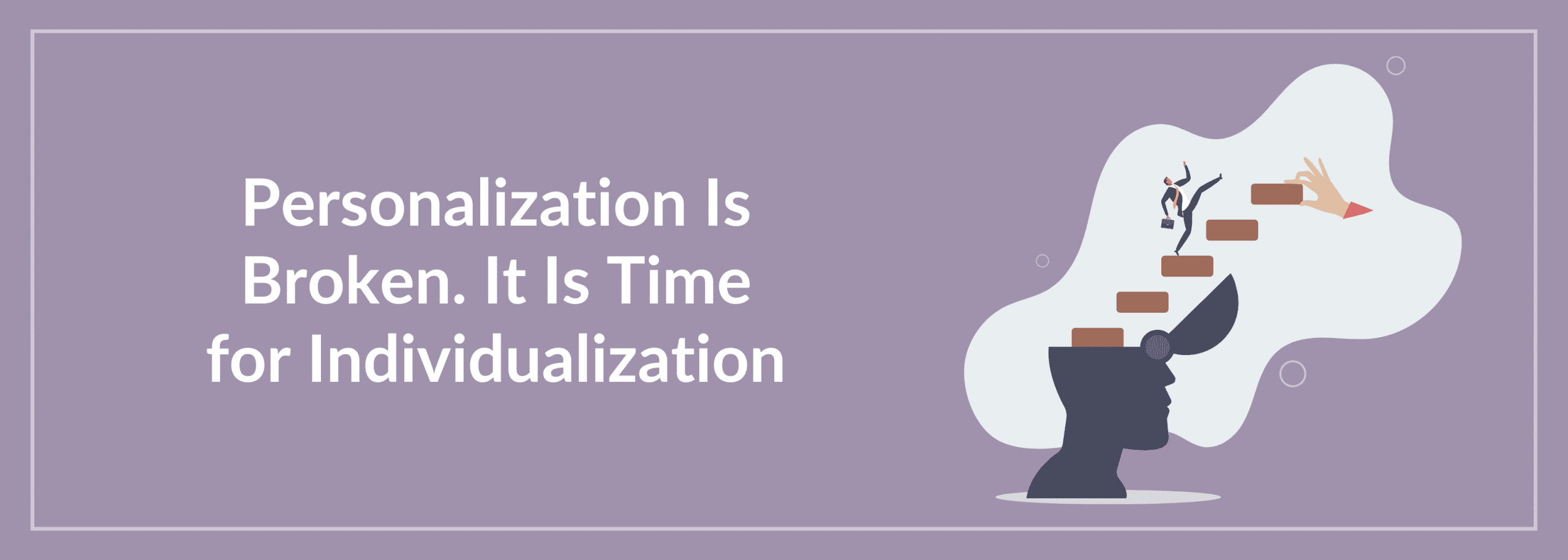Personalization Is Broken. It Is Time for Individualization
I attended a demo of a website personalization tool a couple of days ago. During the demonstration, they took me through the process of how their tool works.
They spoke about segmentation, personas, experience, goals, interests, and behavior in this order. I understood that, as a customer, I would have to look at the process in reverse. I have to define my goals, then the experience for different personas and the customer segmentation.
This got me thinking.
Is this the best way to look at personalization?
Would today’s customers be happy to receive personalization based on generic segmentation like age, gender, location, income levels, etc.?
Shouldn’t there be individualization for customers?
Unlike in the past, today, customers leave behind a breadcrumb trail of preferences, habits, and real-time context. Given this context, it doesn’t make sense to look at static segmentation of the past.
It Is All About Individualization
As a brand, you have to curate a uniquely relevant experience for each of your customers based on who they are, what they want right now, and where they are in their journey.
There is a huge difference between a college student who is trying to buy a laptop on a budget versus a corporate headman who is comparing specifications of high-end notebooks on the same website.
Both of them will have to be offered a custom experience suited to their needs.
How Do You Go from Segmentation to True Individualization?
Defining the goals is the most important step. To achieve individualization, the first step is to recalibrate what success looks like.
Step 1: Move from Campaign Metrics to Experience Metrics
Are you focusing on outputs instead of outcomes?
Don’t look at email open rates, ad impressions, and click-throughs. Instead, focus on the time spent on the platform, reduced churn, upsell success, and long-term customer value.
Let me give you an example.
Don’t measure how many customers opened a promotional SMS. Would it make sense to measure how many returned to the app or website within 48 hours and made a transaction?
Step 2: Define Personalization KPIs
Your goals should follow the customer journey. Look at these metrics:
- What percentage of first-time visitors engaged with tailored content?
- What percentage of product views led to add-to-cart for recommended items?
- What percentage of customers completed checkout after receiving dynamic pricing or offers?
- What percentage of customers made a repeat purchase after sending customized loyalty offers?
Often, we make the mistake of showing every offer to every customer. However, true personalization is about showing fewer, more relevant messages to fewer people.
Step 3: Make Use of Technology to Scale Personalization (Individualization)
The complexity of tailoring experiences for millions of unique users is impossible without technology.
Move Away from Demography to Behavioral Data
You should lean into the behavior of people on your app and website. What people do tells you more than who they are.
Let me give you two successful examples.
- Netflix does not look at your demography. It looks at you watch history to recommend shows.
- Spotify has this concept called ‘Discover Weekly.” It tailors music suggestions based not just on your past listens but also on how similar listeners responded to those songs.
Have AI and Machine Learning as a Part of the Mix
AI models analyze behavior at scale to deliver instant personalization.
For instance, Amazon uses real-time machine learning to suggest items based on what you’re currently browsing, your past orders, and what similar profiles have bought. It does all of this in milliseconds.
Amazon’s recommendation engine drives about 30% of its sales.
Omnichannel Capabilities
Omnichannel solution unifies data from all touchpoints, such as website, mobile, email, POS, and CRM, to create a single customer view.
Based on the customer interactions across channels, you can tailor experiences relevant to the customer across the journey.
Intent Recognition
Technology can help you infer intent by combining behavioral cues.
For instance, I checked hotel availability in Bandra multiple times over three days. The travel app understood the high intent and sent me a limited-time discount with a flexible booking option of 100% refund on cancellation.
I liked the offer and confirmed a booking immediately.
Step 4: Don’t Just Personalize, Do Empathize
I regularly order food through a food delivery app. Most of my choices were related to meat.
A few months ago, I signed up for a holistic health program, which mandated that I avoid meat for 90 days. So, invariably, all my orders turned vegetarian on the food delivery app.
After about a week, I received an offer with the caption, “Planning for a meatless week,” here are a few suggestions.
I was thrilled and jumped at the different options and offers.
All of these not only help customers and the brands scale the relationship, but they build customer trust and loyalty.
Personalization is all about understanding that no two customers are alike, and every interaction is a chance to build a relationship.
In a world flooded with content, offers, and noise, the brands that win are the ones that make the customer feel seen.
Here is the paradox: As personalization scales through technology, the experience must feel more human.
After all, customers remember personalized experiences for a long time, and those become the narratives of your brand in the customer’s mind.
